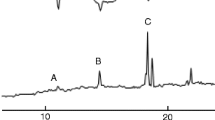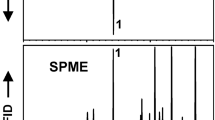Abstract
Sex attractants for three species of geometrid moths were discovered during field screening of 3Z,6Z,9Z-trienes, and the racemic monoepoxydienes derived therefrom. MaleProbole amicaria moths were attracted to lure blends containing 6Z,9Z-cis-3,4-epoxy-nonadecadiene (6Z,9Z-cis-3,4-epoxy-19∶H) with 3Z,9Z-cis-6,7-epoxy-19∶H. 3Z,6Z,9Z-19∶H was positively identified and 6Z,9Z-cis-3,4-epoxy-19∶H was tentatively identified in extracts of female pheromone glands by coupled gas chromatography-electroantennogram detection (GC-EAD) and gas chromatography-mass spectrometry (GC-MS).Sicya macularia male moths were attracted by blends of 3Z,6Z,9Z-19∶H and 6Z,9Z-cis-3,4-epoxy-19∶H. The attractive response was strongly antagonized by small amounts of 3Z,9Z-cis-6,7-epoxy-19∶H, or by larger amounts of 3Z,6Z-cis-9,10-epoxy-19∶H.Lomographa semiclarata male moths were attracted by a variety of lures containing 3Z,6Z,9Z-17∶H as a major component. 3Z,6Z,9Z-17∶H was tentatively identified in a female pheromone gland extract by GC-EAD.
Similar content being viewed by others
References
Arn, H., Stadler, E., andRauscher, S. 1975. The electroantennographic detector—a selective and sensitive tool in gas chromatographic analysis of insect pherornones.Z. Naturforsch. 30c:722–725.
Arn, H.,Tóth, M., andPriesner, E. 1986. List of sex pherornones of Lepidoptera and related attractants. OILB-SROP/IOBC-WPRS Secrétariat Général, 149 Rue de Bercy, F-75595 Paris cedex 12, France; ISBN 92-9067-002-9.
Becker, D., Moore, I., Kimble, T., Cyjon, R., Cosse, A., andWysoki, M. 1985. Sex attractano compounds of the giant looper,Boarmia selenaria.Phytoparasitica 13:150.
Becker, D., Moore, I., Cyjon, R., Kimmel, T., Cosse, A., andWysoki, M. 1987. The active component in the sex pheromone of the giant looper,Boarmia selenaria.Phytoparasitica 15:160.
Bell, T.W., andMeinwald, J. 1986. Pherornones of two arctiid moths (Creatonotos transiens andC. gangis): Chiral components from both sexes and achiral female components.J. Chem. Ecol. 12:385–409.
Chisholm, M.D., Steck, W.F., Arthur, A.P., andUnderhill, E.W. 1975. Evidence for cis-11-hexadecen-1-ol acetate as a major component of the sex pheromone of the bertha armyworm,Mamestra configurata (Lepidoptera: Noctuidae).Can. Entomo. 107:361–366.
Descoins, C., andFrérot, B. 1984. XVIIth International Symposium of Entomology, Hamburg, August 20–26, 1984.
Duncan, D.E. 1955. Multiple range and multiple F tests.Biometrics 11:1–41.
Hill, A.S., andRoelofs, W.L. 1981. Sex pheromone of the saltmarsh caterpillar moth,Estigmene acrea.J. Chem. Ecol. 7:655–668.
Hill, A.S., Kovalev, B.G., Nikolaeva, L.N., andRoelofs, W.L. 1982. Sex pheromone of the fall webworm moth,Hyphantria cunea.J. Chem. Ecol. 8:383–396.
Millar, J.G.,Wong, J.W., andUnderhill, E.W. 1985. Synthesis of chiral diene epoxides, attractant for several lepidopteran species. Paper CO-08, International Symposium on the Chemistry of Natural Products, June 23–26, 1985. Edmonton, Alberta, Canada.
Millar, J.G., Underhill, E.W., Giblin, M., andBarton, D. 1987. Sex pheromone components of three species ofSemiothisa (Geometridae), (Z,Z,Z)-3,6,9-heptadecatriene and two monoepoxydiene analogs.J. Chem. Ecol. 13:1371–1383.
Millar, J.G., Giblin, M., Barton, D., Morrison, A., andUnderhill, E.W. 1990. Synthesis and field testing of enantiomers of 6Z,9Z-cis-3,4-epoxydienes as sex attractants for geometrid moths: Interactions of enantiomers and regioisomers.J. Chem. Ecol. 16:2317–2339.
Sokal, R.R., andRohlf, F.J. 1981. Biometry, 2nd ed., W.H. Freeman and Co., New York. 403 pp.
Underhill, E.W., Palaniswamy, P., Abrams, S.R., Bailey, B.K., Steck, W.F., andChisholm, M.D. 1983. Triunsaturated hydrocarbons, sex pheromone components ofCaenurgina erechtea.J. Chem. Ecol. 9:1413–1423.
Wong, J.W., Underhill, E.W., Mackenzie, S.L., andChisholm, M.D. 1985. Sex attractants for geometrid and noctuid moths. Field trapping and electroantennographic responses to triene hydrocarbons and monoepoxydiene derivatives.J. Chem. Ecol. 11:727–756.
Author information
Authors and Affiliations
Additional information
Issued as NRCC No. 30258.
Rights and permissions
About this article
Cite this article
Millar, J.G., Giblin, M., Barton, D. et al. 3Z,6Z,9Z-Trienes and unsaturated epoxides as sex attractants for geometrid moths. J Chem Ecol 16, 2307–2316 (1990). https://doi.org/10.1007/BF01026940
Received:
Accepted:
Issue Date:
DOI: https://doi.org/10.1007/BF01026940




